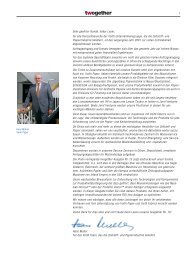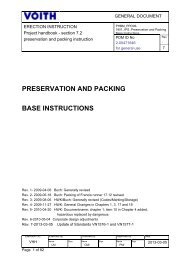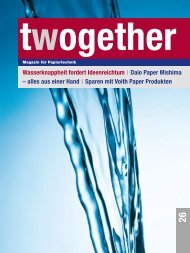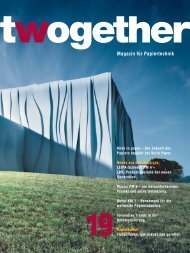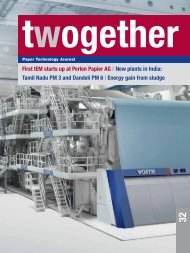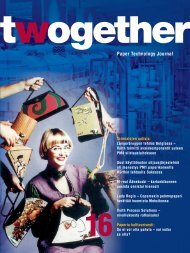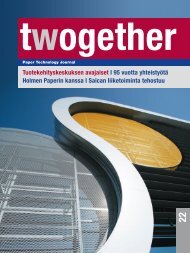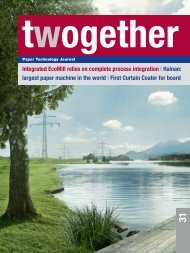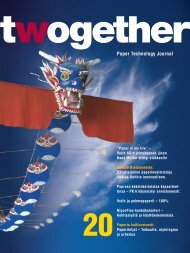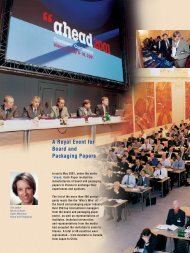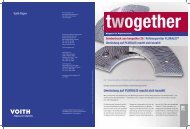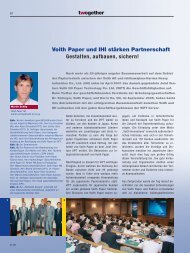You also want an ePaper? Increase the reach of your titles
YUMPU automatically turns print PDFs into web optimized ePapers that Google loves.
4<br />
Fig. 5: Total BHKP Consumption in the World<br />
by Subgrade.<br />
Fig. 6: Furnish Composition of Fine <strong>Paper</strong>.<br />
5<br />
Million tons<br />
80<br />
Forecast<br />
70<br />
60<br />
50<br />
40<br />
30<br />
20<br />
10<br />
Acacia<br />
Mixed tropical<br />
1980 1985 1990 1995 2000 2005 2010 2015<br />
The total paper making fiber consumption<br />
at 2002 is about 325 million t and it will<br />
be about 460 million t at 2015. It is important<br />
to know that recovered paper<br />
provides already 50 % of the worlds consumption<br />
of paper making fiber. Bleached<br />
hardwood kraft consumption is also expected<br />
to increase and MTH contributes<br />
as one source among many others<br />
(Fig. 4). Bleached hardwood kraft pulp<br />
(BHKP) consumption will grow from<br />
47.5 million t at 2002 up to 70 million t at<br />
2015 (Fig. 5).<br />
MTH Plays a Marginal Role in<br />
Pulp and <strong>Paper</strong> Production<br />
The world production of MTH pulp is<br />
estimated at around 3.5 million tons<br />
(Fig. 5). This is about 1 % of the total<br />
papermaking fibre supply (325 million<br />
tons) and about 2 % of virgin wood pulp<br />
production (161 million tons). Indonesia<br />
<strong>17</strong>/04<br />
Birch<br />
Eucalyptus<br />
Mixed northern<br />
Mixed southern<br />
currently accounts for most of the<br />
world’s MTH pulp production.<br />
Most of the MTH-pulp is used for the<br />
production of fine paper. Fine paper is a<br />
general term for Copy <strong>Paper</strong>s, Woodfree<br />
Writing and Printing <strong>Paper</strong>s (uncoated)<br />
and Art <strong>Paper</strong>s (coated grades). The different<br />
papers consist mainly of reinforcement<br />
pulp (kraft pulp-long fiber), hardwood<br />
pulp such as e.g. MTH-pulp (short<br />
fiber) and filler material (calcium carbonate<br />
and/or clay). Further additives (starch,<br />
dye, e.g.) and coatings on art paper (pigments,<br />
binders, etc.) are a must in order<br />
to achieve further improvements on certain<br />
important paper properties (Fig. 6).<br />
There are several reasons why MTH is<br />
not favoured from paper makers and paper<br />
machine suppliers. One of the most<br />
important is the large number of wood<br />
species, leading to large variations in the<br />
most important wood properties, which<br />
Copy Writing and Art <strong>Paper</strong><br />
<strong>Paper</strong> Printing <strong>Paper</strong> (coated)<br />
(uncoated)<br />
Weight (g/m 2 ) 80 70-120 70-<strong>17</strong>0<br />
Softwood Pulp (%) 0-15 0-20 10-60<br />
Hardwood Pulp (%) 85-100 80-100 40-90<br />
Filler (%) <strong>17</strong>-25 10-25 10-20<br />
Coating Pigment (%) up to 60 %,<br />
based on<br />
base paper<br />
has an undesirable impact on the pulping<br />
process, and ultimately on pulp and paper<br />
quality. In some cases, for example<br />
the species with the highest density have<br />
to be separated before processing the<br />
raw material mix. The big variations in<br />
wood properties make it difficult to control<br />
and optimise the process, resulting<br />
in low yield.<br />
Indonesia is the only country where MTH<br />
is used in large-scale pulp production.<br />
Driven by the growing demand for fibre<br />
in Asia, Indonesia’s pulp production is<br />
expected to increase from 3.5 million<br />
tons in 2000 to 7.2 million tons in 2015.<br />
Pulp production provides, directly and indirectly,<br />
significant employment and income<br />
opportunities for a large number of<br />
rural people in remote areas. Despite the<br />
rapidly growing pulp production, the use<br />
of MTH is expected to decrease in line<br />
with the increasing use of plantationgrown<br />
acacia.<br />
6



